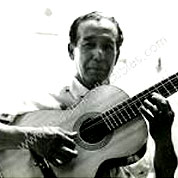 GENIAL CANTAUTOR MIGUEL MATAMOROS CUMPLE AÑOS DE NACIDO.
GENIAL CANTAUTOR MIGUEL MATAMOROS CUMPLE AÑOS DE NACIDO.
Guitarrista y compositor de formación autodidacta, que incursionó en casi todos los géneros y ritmos de la música popular cubana, Miguel Matamoros disfrutó de enorme popularidad y fama. Oriundo de Santiago de Cuba, Miguel Matamoros nació el 8 de mayo de 1894 en el popular barrio Los Hoyos.
Antes de convertirse en el autor de numerosos temas considerados clásicos, Miguel Matamoros trabajó como chofer, carpintero, monaguillo de la Iglesia del Cristo, fabricante de losas y alfarero. A la edad de 15 años, ya tocaba guitarra, un arte que aprendió en la calle, con los amigos, dando serenatas y amenizando fiestas populares en los barrios de Santiago.
En 1910, con 16 años de edad, compuso su primera pieza musical: un bolero que tituló ‘El Consejo’. A partir de entonces realizaría muchas otras obras hasta llegar a alrededor de 198 donde se incluirían boleros, sones, pasodobles, habaneras y polcas, entre otros. Curiosamente, nunca incursionó en la rumba, y algunas de sus grandes obras se relacionaron con la trova tradicional.
Otro 8 de mayo, pero de 1925, fundó el Trío Matamoros, con Rafael Cueto, guitarra, y Siro Rodríguez, maracas y segunda voz. Tres años después hizo su primer viaje a Estados Unidos, y luego estuvieron de gira por varios países de América Latina y el Caribe.
En 1938 fue miembro de un jurado integrado, además, por Gonzalo Roig, Rita Montaner y Eliseo Grenet, que premió a Celia Cruz, en un concurso para elegir a la reina de la conga, organizado por Radio Lavín – Mil Diez. En 1943 el Trío Matamoros trabaja en las radioemisoras CMQ y Mil Diez, y en esta última se le incorpora Benny Moré como cantante.
En 1960 realizó su último viaje a los Estados Unidos, a su regreso se retiró de la vida artística, y el Trío se desintegró. Miguel Matamoros falleció el 15 de abril de 1971 en Santiago de Cuba.
Entre sus diez más conocidas creaciones se cuentan las siguientes: Lágrimas negras; Ay Mamá, son de la loma; El que siembra su maíz; La Mujer de Antonio; Juramento; Mariposita de primavera; Camarón y mamoncillo; Triste muy triste; El Paralítico y Dulce embeleso entre otros muchos.
 DISTINGUISHED COMPOSER MIGUEL MATAMOROS BIRTHDAY.
DISTINGUISHED COMPOSER MIGUEL MATAMOROS BIRTHDAY.
A guitarist and self-taught composer, who ventured into almost every genre and rhythm of Cuban popular music, Miguel Matamoros enjoyed enormous popularity and fame. Originally from Santiago de Cuba, Miguel Matamoros was born on May 8, 1894, in the popular neighborhood of Los Hoyos.
Before becoming the author of numerous topics considered classic, Miguel Matamoros worked as a driver, carpenter, altar boy of the Church of Christ, maker of slabs and potter. At the age of 15, he already played guitar, an art he learned on the street, with friends, serenades and entertaining popular festivals in the neighborhoods of Santiago.
In 1910, when he was 16 years old, he composed his first musical piece: a bolero that he titled ‘The Council’. From then on, he would perform many other works until he reached around 198, where he would include boleros, sones, pasodobles, habaneras and polkas, among others. Curiously, he never ventured into the rumba, and some of his great works were related to the traditional trova.
Another May 8, but from 1925, he founded the Trío Matamoros, with Rafael Cueto, guitar, and Siro Rodríguez, maracas and second voice. Three years later he made his first trip to the United States, and then they toured several countries in Latin America and the Caribbean.
In 1938 he was a member of an integrated jury, in addition, by Gonzalo Roig, Rita Montaner, and Eliseo Grenet, who awarded Celia Cruz, in a contest to elect the queen of the conga, organized by Radio Lavín – Mil Diez. In 1943, the Trío Matamoros works on the CMQ and Mil Diez radio stations, and Benny Moré joins the latter as a singer.
https://youtu.be/ATiAPYJbi3g
In 1960 he made his last trip to the United States, upon his return he retired from artistic life, and the Trio disintegrated. Miguel Matamoros died on April 15, 1971, in Santiago de Cuba.
Among his ten best-known creations are the following: Lágrimas negras; Ay Mamá, son de la loma; El que siembra su maíz; La Mujer de Antonio; Juramento; Mariposita de primavera; Camarón y mamoncillo; Triste muy triste; El Paralítico y Dulce embeleso among many others.
Agencies/ CiberCuba/ Joel del Rio/ Extractos/ Excerpts/ Internet Photos/ YouTube/ Arnoldo Varona/ www.TheCubanHistory.com
THE CUBAN HISTORY, HOLLYWOOD.



 < DISTINGUISHED Composer Miguel Matamoros Birthday. VIDEOS.
< DISTINGUISHED Composer Miguel Matamoros Birthday. VIDEOS.
